Beautiful Plants For Your Interior
Gardening Month by Month – August
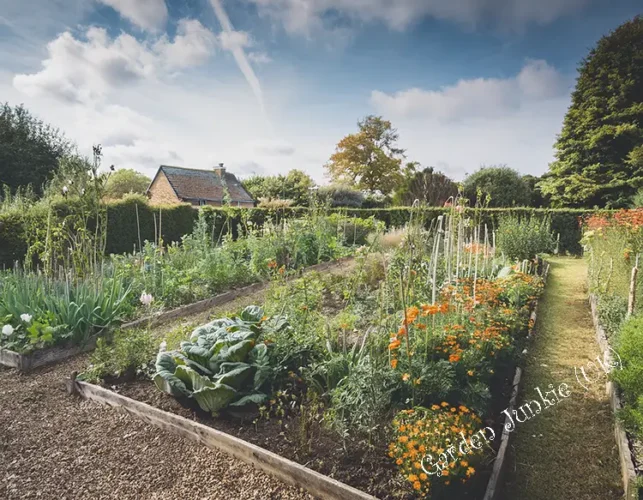
Choose Your Gardening Month by Month – August
Gardening Month by Month – August, sets out and provides like every month of our gardening calendar, practical, informative checklists and reminders to help guide you through various gardening tasks for the month. For every month of the year, we provide this regular monthly gardening section for our readers, which hopefully you all find beneficial in some way.
Many of these gardening activities are tailored to specific months or even certain types of gardens, plants, and or environments, therefore not all tips and information may be useful. However, on this page, we looked at what tasks may require your focus in and around the garden, allotment, pond and greenhouse during August.
August marks a pivotal point in the gardening calendar, as the summer weather continues to influence plant growth and garden maintenance. This month is crucial for you to assess the health of your garden, manage any pests and diseases, and prepare for the Autumn ahead. Whether you’re nurturing summer blooms or planning for autumn harvests, understanding the specific tasks for August can help ensure a thriving garden.
Just a word about pruning!
Under the Wildlife & Countryside Act 1981, it is illegal to intentionally damage, destroy, or take the nest of any wild bird while it is in use or being built, as well as to destroy any wild bird eggs. This law limits hedge pruning during the bird breeding season. However, by August, it is typically accepted that most birds have completed nesting, allowing for hedge pruning.
While the Act does not specify exact dates, the main bird breeding season is generally recognised as occurring from March 1 to July 31. It is still the responsibility, of the householder to check the hedge for nesting birds, even outside this primary season, to ensure compliance.
Moving on, as we delve deeper into the specific gardening tasks for August, you’ll discover our tips and techniques to maximise your garden’s potential during this critical time of year.
Gardening Month by Month – August (Quick Tips)
Generally, during August, gardeners should focus on good watering practices, like mulching, (which will help slow down the evaporation of moisture from the soil), and pruning to help maintain plant vitality. It’s also an ideal time to sow seeds for Autumn crops and to take ‘cuttings’ from perennials to propagate for next year.
For ponds, August is a great time for ‘general’ garden pond care, monitoring algae growth and ensuring a healthy aquatic environment. Regularly remove debris and fallen leaves to prevent decay that can lead to poor water quality.
On the allotment, August is the perfect time to harvest summer crops where regular picking encourages further fruit and vegetable production and prevents plants from becoming overripe.
In August: Garden, Allotment, Flowers, Greenhouse.
August brings a vibrant display of colour to the garden. Deadhead regularly to prolong flowering and encourage new blooms. Keep an eye out for pests and diseases, and treat them promptly to protect your plants.
Don’t forget to sow quick-growing salad leaves for a continuous supply. This is also a good time to prepare the soil for autumn planting by adding compost or manure.
Maintain a vigilant watch on your greenhouse in August. Ventilate well to prevent overheating, and water regularly, especially for container plants.
In Addition:
Checkout Our August Gardening Checklist:
- Deadhead roses, dahlias, and any summer ‘perennials’ that still have additional buds. Regularly do the same for annual bedding plants to prevent them from setting seed. This practice encourages more vigorous flowering, allowing them to continue blooming into the autumn.
- Take your greenhouse plants outside and hose them down to assist with pest management.
- Plant autumn bulbs like Crocus, Daffodils, and Nerines in both pots and garden borders.
- As summer progresses, roses also become increasingly susceptible to black spot, which causes leaves to yellow and develop dark spots, leading to leaf drop. It’s important to remove the affected leaves and dispose of them properly (avoid composting) and to apply a fungicide spray to manage the issue.
- While deadheading helps you manage your garden and promote new blooms, leaving some seed heads can add visual appeal. Additionally, it provides an opportunity to collect and ‘save seeds’ before they naturally drop.
- Give special attention to container plants this month, as their roots will be tightly packed by this time, requiring increased feeding, watering, and deadheading to maintain their appearance.
- Be decisive with any plants in containers that are clearly beyond saving, particularly those that have dried out significantly. Remove them and replace them with fresh fuchsias, pelargoniums, or autumn pansies in new compost. Consider adding water-retaining gel crystals to help retain moisture.
- To ensure Wisteria blooms annually, regular pruning is crucial. Prune in summer (August) and winter (February) for a beautiful shrub. For helpful tips on how to summer prune Wisteria, check out this Wisteria pruning video.
- For lawns planted on thin or a poor soil base, consider using a high phosphate fertiliser. This will help strengthen the roots for winter, instead of promoting excessive top growth that may be vulnerable to cold conditions and weaken the grass.
- You can sow directly in the ground hardy annuals, like poppies, sunflowers and dill in bright, sunny locations to ensure vibrant colours in your garden by early summer next year.
- Prune/Trim lavender after it has finished blooming to keep it compact and bushy, but be careful not to cut into the old wood.
- Take geranium cuttings now, as they are actively growing and will root quickly, providing you with plants for your windowsill throughout the winter.
- Even though weeds grow more slowly than in the spring, it’s a good idea to keep hoeing the soil to suppress them. This should be done in warm, dry conditions to help any remaining weed seedlings on the surface dehydrate and die.
- Plant foxgloves, sweet rocket, sweet williams, and other perennials now to allow their roots to establish and promote significant growth before autumn.
- Avoid removing the flowerheads/inflorescence of ornamental grasses, as they add visual interest during the winter months.
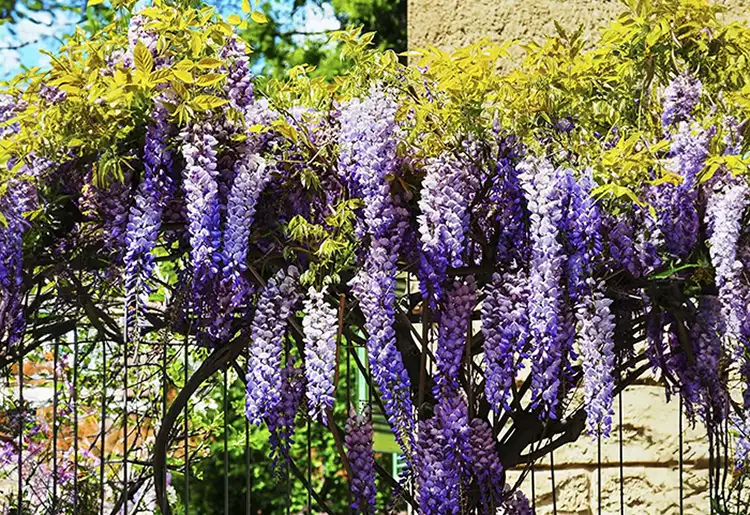
Gardening Month by Month – August: You Can Prune Wisteria This Month to Help Ensure Blooming Throughout The Year.
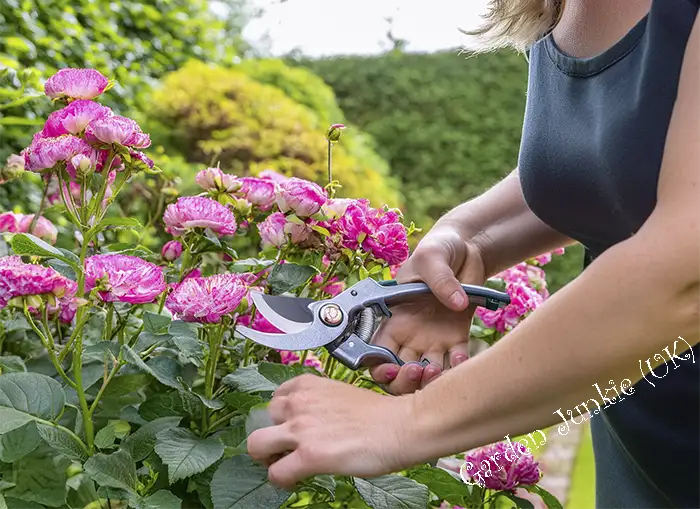
Gardening Month by Month – August: Deadhead Your Flower Regularly to Prolong Flowering And Encourage New Fresh Blooms.
In August: Fruit & Veg
August is a bountiful month for fruit and vegetables in the UK, marking the height of summer harvests. Many delicious varieties of soft fruits are at their peak, including blackberries, raspberries, and strawberries.
In terms of vegetables, August brings a diverse selection to the table. Crops such as tomatoes, courgettes, and cucumbers thrive in the summer heat, providing vibrant colours and flavours for salads and other dishes.
In Addition:
- Try improving soils with green manures. Green manures are quick-growing plants such as Phacelia and Mustard that are planted to cover bare soil. Commonly used in vegetable gardens, their leaves help suppress weeds while their roots protect against soil erosion. When incorporated into the soil while still green, they enrich the soil with valuable nutrients and enhance its structure.
- After they have produced fruit, the canes of summer-fruiting raspberries should be cut back to the ground.
- Lots of your crops can be harvested in August if you have them. These include beetroot, carrots, cucumbers, courgettes, runner beans, globe artichokes, and second early potatoes, with maincrops potentially ready by the end of the month. Additionally, you can harvest onions and shallots; ensure to let them dry in a sunny location before storing them.
- You can still sow a variety of crops in August for harvests extending into autumn and beyond. These include lettuce (which should be kept out of direct sunlight though), rocket, spring onions, radishes, mustard leaf and lamb’s lettuce and winter salads.
- Keep a close eye on your tomatoes and potatoes for signs of blight, which will initially appear on the leaves. This can often be prevented using Bordeaux mixture (a fungicide and bactericide made from copper sulfate, calcium hydroxide (lime), and water). Additionally, you can protect potatoes by earthing up the tubers.
- Another issue to monitor is blossom end rot on your tomatoes, which initially appears as a brown or black spot on the fruit that enlarges and becomes sunken. To prevent blossom end rot, ensure frequent watering, as this condition is often caused by a lack of calcium in the plants.
- Keep an eye out for seed potatoes to grow new potatoes for Christmas. These prepared tubers can be planted now in a frost-free greenhouse or in containers that can be moved indoors when it gets cold. They will take approximately 12 weeks from planting to harvest.
- Lift and pot up/transplant strawberry runners (stolons) to a new location.
- Inspect your fruit trees for brown rot and promptly remove any affected fruit to help prevent its spread.
- Summer prune, trained apples and pears, particularly those shaped as cordons, espaliers, fans, pyramids, and stepovers. This practice helps sunlight reach the fruit for better ripening and promotes good cropping for the following year.
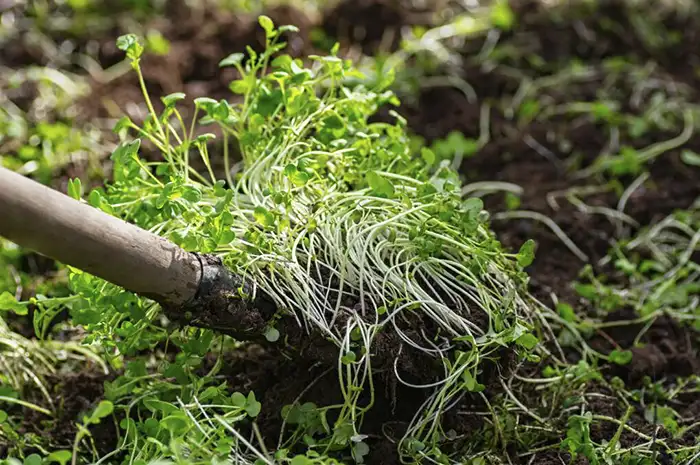
Gardening Month by Month – August: Try Improving Your Soil by Planting and Digging in Crops For Green Manure.
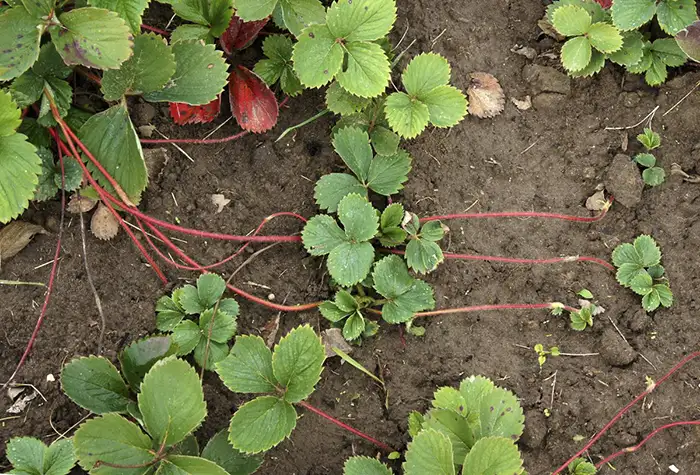
Gardening Month by Month – August: Pot up Strawberry Runners to a New Location.
In August: Pond Care
In August, garden ponds in the UK require specific maintenance to ensure they remain healthy and vibrant as summer reaches its peak. This month is crucial for managing aquatic plants, as many will have grown significantly and may need thinning. Oxygenating plants like Elodea can become overgrown, potentially affecting water quality and fish health.
Another important aspect of pond care in August is monitoring water levels and quality. Hot weather can lead to evaporation, so topping up the pond with fresh water is essential. It’s also advisable to check for algae blooms, which can thrive in warm temperatures.
Finally, August is an excellent time for wildlife observation. Many creatures are active, and ‘pond-dipping’ can reveal a variety of species, making it an enjoyable educational experience for families. Engaging with the local ecosystem not only enhances appreciation for biodiversity but also encourages the health of the pond itself.
In Addition:
- Oxygenating plants such as Elodea and Hornwort tend to grow vigorously during the summer and will require thinning. Limit the clump to no more than one-third of the pond’s surface area by removing the older, darker stems while keeping the fresh green ones. Place the removed foliage at the pond’s edge to allow any pond insect life to crawl back in if needed, and then compost the rest.
- Continue to top up the water in ponds and water features as needed. To aerate the water during hot, humid weather, leave fountains running overnight.
- Waterfalls/water features can become clogged with algae, leaves, and debris, so remove these obstructions by hand or with a stiff brush to ensure the water can flow freely.
- Perform a nitrate test to check the levels in your pond. The more frequently you change the water, the lower the nitrate levels should become. Regular water changes also help buffer pH and support fish growth. Always remember to use a dechlorinator.
- During the summer season, there are many herons present, and they become bolder as the summer progresses, often appearing during the day and approaching residential areas. To effectively safeguard your fish, it’s essential to use a securely fitted cover net. Just consider elevating the net above the water’s surface and or reducing the water level, as this can help prevent determined herons from reaching through the net and harming the fish.
- Some fish may develop ulcers during the summer months, so it’s important to change the water as necessary, clean the filter, and ensure the UV system is functioning correctly. If necessary, use anti-ulcer medication to address the issue, you may even need to reduce the fish population if overcrowding is a problem. Ulcers are bacterial infections that thrive in stressed fish and poor water conditions.
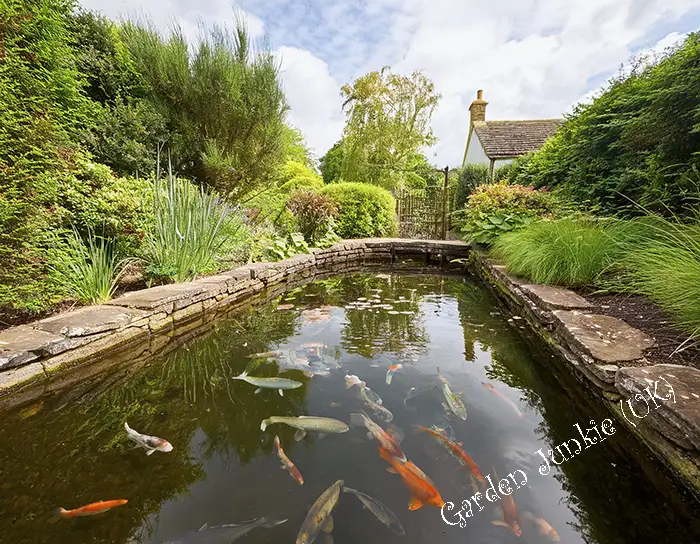
Gardening Month by Month – August: It’s Important to Airate the Water, to Avoid Bacterial Infections in Your Fish
In August: General Garden Maintenance
August is generally a time to relax in the garden, a time to fire up the BBQ again with family and friends, after all the hard work you’ve put in over the previous months of the year.
However, maintaining you’re garden structures is also essential to ensure that they remain functional and aesthetically pleasing as summer transitions into autumn.
- August as in July is an ideal time to continue to inspect fences, trellises, and garden furniture for signs of wear and tear caused by the summer sun and rain. Carrying out repairs as quickly as possible, to prevent further deterioration and help extend their life.
- Regular maintenance ensures your greenhouse provides optimal growing conditions regularly clean panes to maximise light penetration. Also, check for broken or missing panes and replace them promptly. Inspect the ‘frame’ for damage and repair as needed.
- Ensure greenhouse ventilation is working efficiently to prevent overheating. Clean gutters and downpipes to avoid waterlogging.
- Check patios and paths for weeds pushing through cracks. Remove these promptly to prevent damage.
- August is also a great time to clean and maintain your garden tools. After a busy summer, ensure they are free from dirt and rust. Sharpen blades and check for any repairs before the autumn gardening season begins. Proper maintenance will extend the life of your tools and improve their performance.
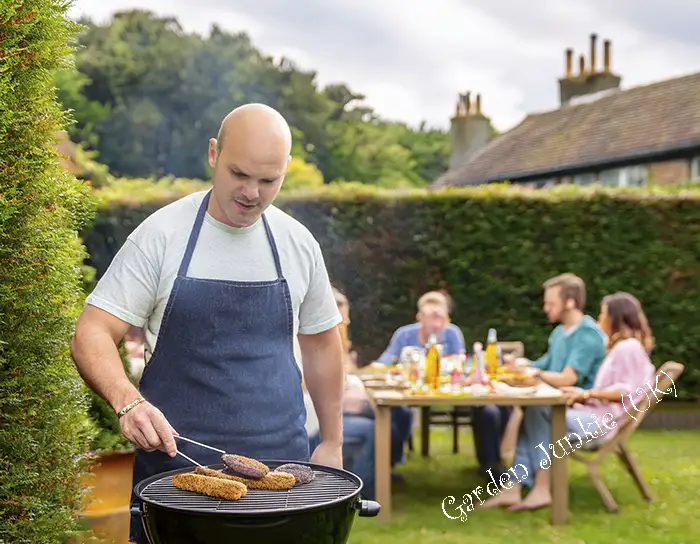
Gardening Month by Month – August: Time to Relax With Family And Friends Fire up a BBQ.
FAQ’s
What is the significance of the ‘August Moon’ for gardeners?
The ‘August Moon’ refers to the full moon in August, which is traditionally seen as a time to sow seeds for autumn crops and green manures. Many gardeners believe that planting during this time can enhance growth due to the increased moisture in the soil caused by the moon’s gravitational pull.
What should I do with my summer flowering bulbs in August?
After the blooms have faded, it’s crucial to allow the foliage of summer flowering bulbs like gladiolus and lilies to die back naturally. This process helps the bulbs store energy for next year. Avoid cutting them back until the leaves turn yellow, and consider lifting them if you live in an area prone to frost.
How can I prepare my garden for wildlife as summer ends?
As summer transitions to autumn, you can prepare your garden for wildlife by leaving some areas wild, such as a patch of uncut grass or a pile of leaves. This provides shelter for insects and small animals like hedgehogs for example. Additionally, consider planting berry-producing shrubs to provide food for birds.
